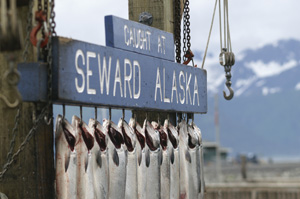
Wild salmon will be a naturally occurring, deep orange-red, with less “marbling” than the farmed fish, because salmon in their natural habitat feed on krill.
by Lynn O’Neill —
If you have read about the health benefits of fish (high in omega-3s and protein, low in fat) but your mind is still roiling about which fish are safe to eat and which are properly eco-harvested, you may think there is something very “fishy” and confusing about the fish world — and you would be correct. So how do you begin to navigate through the turbulent seas of information which seem to change by the day?
A few easy guidelines
Look for “wild caught” or “sustainably raised” fish, which according to the MSC Standard (Marine Stewardship Council) means target fish populations are at healthy levels, sometimes having recovered from being depleted. A well-managed fishery will ensure a future for the industry and all those who depend on fisheries for their livelihoods.
The MSC uses product labels to reward environmentally responsible fishery management and practices. Consumers concerned about overfishing and its environmental and social consequences will be able to choose seafood products that have been independently assessed against the MSC Standard and labeled as such to prove it.
It is the consumer’s job, then, to find reputable vendors and Web sites for timely information. Health food supermarkets are a good place to start, like Whole Foods, Sunflower and Sprouts. Also, more and more conventional grocery stores are beginning to carry wild caught and sustainably farmed fish.
Make time to be a conscientious hunter-gatherer, instead of a consumer zombie, carelessly tossing that poisoned slab of dead marine life into your cart. Always feel empowered to ask questions of your fish vendor. In some cases, the retailers have learned much of what they know from their consumers, rather than the other way around. Remember, the more you, the consumer, ask questions, the more your retailer will be inspired to learn and research.
While the list of fish that are safe to eat can change throughout the year, by and large these types are considered the safest: anchovies, U.S. farmed catfish, Dungeness crab, crawfish, wild Pacific halibut, wild Pacific salmon, Atlantic herring, wild or Alaskan salmon, wild canned salmon, sardines, bay scallops and Uni (sea urchin).
Alaskan wild salmon is the healthiest fish you can buy, but it is abundant in winter only. (A tasty alternative is high-quality, “frozen at sea” (FAS), line-caught fish available in the off-season.) Unfortunately most salmon on restaurant menus and in the supermarkets is likely farm-raised, which means it is loaded with parasiticides, antibiotics, flame retardants and sea lice, and it has been genetically altered and colored with synthetic dyes.
Salmon raised in net pens are like factory-farmed cattle — they are packed tightly and their waste pollutes the waters. Broken pens can result in the escape of thousands of fish, often into areas where they are not native, and they can pass diseases to native stocks and compete with them for food. Farmed salmon require large amounts of wild fish in their feed (it takes two to three pounds of wild fish to raise one pound of farmed salmon). They also contain higher levels of contaminants like PCBs and dioxins.
Farmed salmon are so crammed in with other fish, they cannot adequately use their muscles, which means they cannot convert their food into healthy omega-3s. They become like Big Macs of the sea. Until you begin to transition from conventionally raised to sustainable, it is wise to trim the fat and skin from your fish, since PCBs are stored in the fat cells — in humans and fish alike. Read labels and signs, and consider buying fish from Portugal, where the waters are protected and the fishing communities thrive.
Wild salmon will be a naturally occurring, deep orange-red, with less “marbling” than the farmed fish, because salmon in their natural habitat feed on krill. By eating krill, wild salmon actually ingest less mercury and attain their orange color. Farm-raised fish ingest other bits of fish that have ingested more mercury, so the cycle of pollution continues. High mercury levels in fish are a result of burning fossil fuels.
Some farmed fish, however, are safe to eat if they are farmed responsibly and sustainably. U.S. catfish are considered safe because they are raised on a vegetarian diet, therefore they ingest little mercury and live in clean, native ponds. Some tilapia and striped bass are raised in tanks that recirculate and conserve the water. Some farmed rainbow trout are raised sustainably, as well.
Troll-caught albacore tuna is high in omega-3s but should be eaten in moderation, no more than once a month, because of its mercury levels. Bottom-feeding shellfish eat other fish, so their mercury levels are higher and they should be eaten in moderation. Another fish to eat in moderation is the popular mahi mahi.
Fish to generally avoid are: Atlantic pollock, cod, Pacific red snapper, Atlantic wild salmon and orange roughy, Chilean sea bass, all species of shark, Atlantic swordfish and bluefin tuna.
For help, you can print these pocket seafood guides:
- http://www.oceansalive.org/eat.cfm?contentID=3963
- http://www.environmentaldefense.org/documents/
- 1980_pocket_seafood_selector.pdf.
Lynn O’Neill is a native Arizonan living in California. She is a freelance fiction writer, editor, essayist and natural products broker. jasminatree@yahoo.com.
Reprinted from AzNetNews, Volume 26, Number 5, October/November 2007.





September 14, 2012
Chemical and Toxic Exposure, Environment, Food, Nutrition and Diet